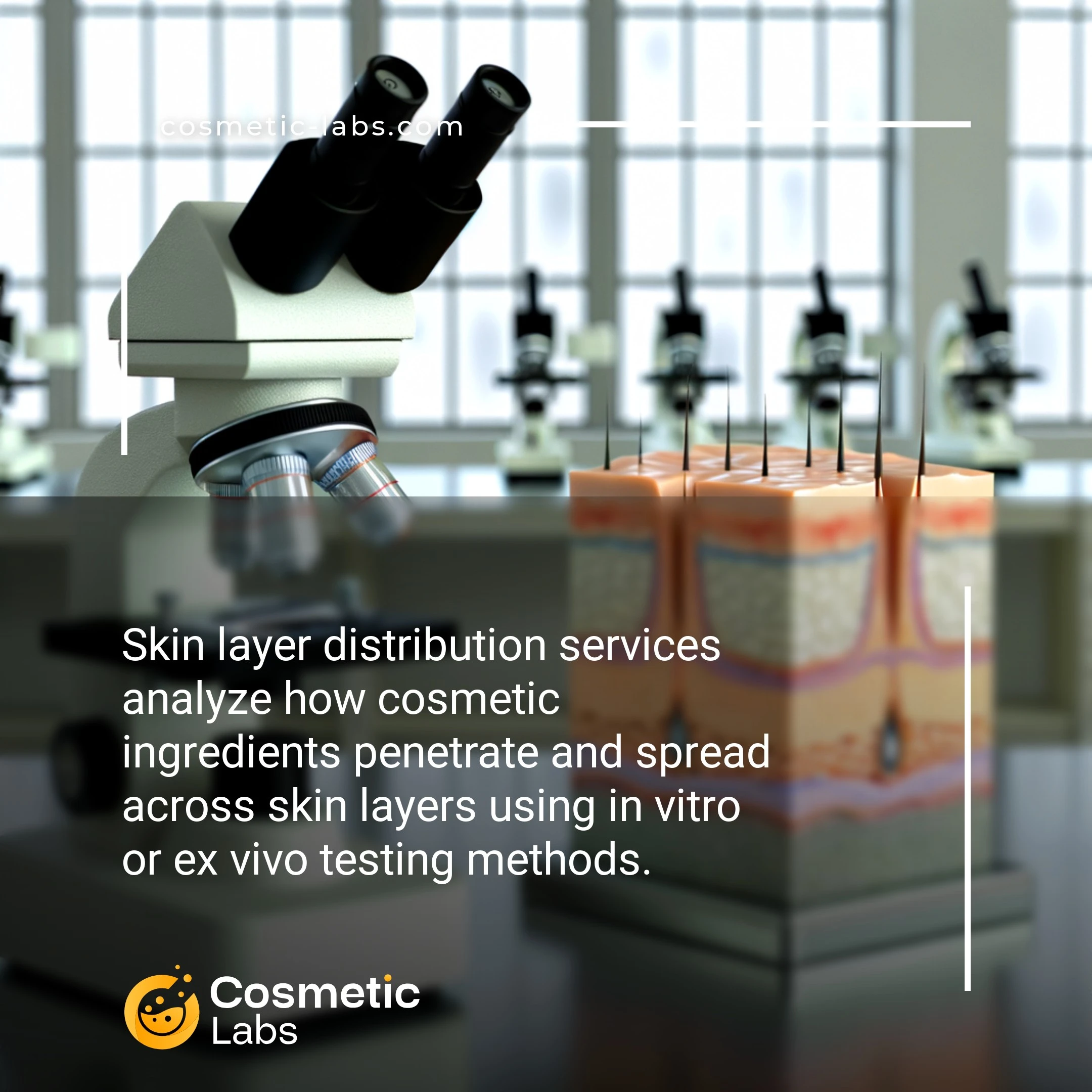Skin Layer Distribution Services for Cosmetic Product Development Partners

What is Skin layer distribution?
Skin layer distribution services track how your cosmetic formulations penetrate through epidermis, dermis, and subcutaneous tissue using advanced imaging and analytical techniques. These preclinical studies show exactly where active ingredients accumulate—whether in the stratum corneum for barrier protection or deeper layers for anti-aging effects—helping you optimize formulations before clinical trials. Labs typically use Franz diffusion cells, confocal microscopy, or tape-stripping methods to map ingredient pathways and concentrations at 2, 6, and 24-hour intervals.
Why do you need this service?
Cosmetic labs apply skin penetration testing to verify that your anti-aging serum’s peptides actually reach the dermis where collagen production occurs, not just sit on the surface. These tests help formulators optimize particle sizes and carrier systems, ensuring your vitamin C cream delivers measurable brightening results in 4-6 weeks rather than empty promises.
Who provides Skin layer distribution services?
All cosmetic labs providing Skin layer distribution services
There is no company providing these services at the moment.
Skin Layer Distribution Analysis Services
Cosmetic labs offering skin layer distribution services help you understand exactly where your product’s active ingredients end up after application. These penetration mapping studies show whether your formulation reaches the stratum corneum, epidermis, or dermis—data you need for both safety assessments and efficacy claims.
Testing Methods and Capabilities
Labs use tape stripping, microdialysis, and confocal microscopy to track ingredient movement through skin layers. Most facilities test on ex vivo human skin samples or reconstructed tissue models, giving you results that closely match real-world application.
- Tape stripping analysis for surface and upper layer distribution
- Franz cell diffusion studies measuring penetration rates
- Fluorescence imaging to visualize ingredient pathways
- HPLC or mass spectrometry for precise concentration measurements
Testing typically takes 2-4 weeks, with labs providing detailed concentration profiles at each skin depth.
Applications for Product Development
Distribution data directly impacts your formulation decisions and marketing claims. Anti-aging actives need dermal penetration, while sunscreens should stay in the upper layers. Labs help you optimize delivery systems like liposomes or penetration enhancers based on where you want ingredients to work.
This testing also supports regulatory submissions in markets requiring percutaneous absorption data. Labs provide study reports formatted for EU, FDA, or other regulatory bodies, including all raw data and statistical analysis your dossier needs.
Practical Applications of Skin Layer Distribution Analysis
Cosmetic labs use skin layer distribution services to map exactly where active ingredients travel within the epidermis, dermis, and subcutaneous tissue after product application.
Active Ingredient Optimization for Targeted Delivery
Labs analyze how formulation vehicles affect ingredient penetration depth. Testing reveals whether actives reach their intended skin layer—retinoids targeting the dermis for collagen stimulation or vitamin C remaining in the epidermis for antioxidant protection.
Distribution studies compare delivery systems like liposomes, nanoparticles, and traditional emulsions. Results show penetration percentages at 2, 6, and 24-hour intervals, allowing formulators to select the most effective carrier for each active ingredient.
Safety Assessment Through Layer-Specific Concentration Mapping
Preclinical labs measure ingredient accumulation in each skin layer to establish safety profiles. Tests determine if actives concentrate at safe levels or require reformulation to prevent irritation.
| Skin Layer | Common Analysis Methods | Typical Timeframe | Key Measurements |
|---|---|---|---|
| Stratum Corneum | Tape stripping, HPLC | 0-6 hours | Surface concentration, barrier function |
| Viable Epidermis | Microtome sectioning, fluorescence | 2-12 hours | Active distribution, cellular uptake |
| Dermis | Franz cell diffusion, mass spectrometry | 6-24 hours | Deep penetration %, systemic exposure |
Distribution mapping helps brands demonstrate product efficacy claims with scientific data showing ingredients reach their target layers at therapeutic concentrations.
